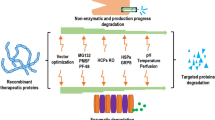Abstract
Abrin obtained from the plant Abrus precatorius inhibits protein synthesis and also triggers apoptosis in cells. Previous studies from our laboratory suggested a link between these two events. Using an active site mutant of abrin A-chain which exhibits 225-fold lower protein synthesis inhibitory activity than the wild-type abrin A-chain, we demonstrate in this study that inhibition of protein synthesis induced by abrin is the major factor triggering unfolded protein response leading to apoptosis. Since abrin A-chain requires the B-chain for internalization into cells, the wild-type and mutant recombinant abrin A-chains were conjugated to native ricin B-chain to generate hybrid toxins, and the toxic effects of the two conjugates were compared. The rate of inhibition of protein synthesis mediated by the mutant ricin B-rABRA (R167L) conjugate was slower than that of the wild-type ricin B-rABRA conjugate as expected. The mutant conjugate activated p38MAPK and caspase-3 similar to its wild-type counterpart although at later time points. Overall, these results confirm that inhibition of protein synthesis is the major event contributing to abrin-mediated apoptosis.







Similar content being viewed by others
References
Hartley MR, Lord JM (2004) Cytotoxic ribosome-inactivating lectins from plants. Biochim Biophys Acta 1701(1–2):1–14. doi:10.1016/j.bbapap.2004.06.004
Nielsen K, Boston RS (2001) Ribosome-inactivating proteins: a plant perspective. Annu Rev Plant Physiol Plant Mol Biol 52:785–816. doi:10.1146/annurev.arplant.52.1.785
Stirpe F, Bailey S, Miller SP, Bodley JW (1988) Modification of ribosomal RNA by ribosome-inactivating proteins from plants. Nucleic Acids Res 16(4):1349–1357
Narayanan S, Surendranath K, Bora N, Surolia A, Karande AA (2005) Ribosome inactivating proteins and apoptosis. FEBS Lett 579(6):1324–1331. doi:10.1016/j.febslet.2005.01.038
Mishra R, Karande AA (2014) Endoplasmic reticulum stress-mediated activation of p38 MAPK, caspase-2 and caspase-8 leads to abrin-induced apoptosis. PLoS One 9(3):e92586. doi:10.1371/journal.pone.0092586
Chen JK, Hung CH, Liaw YC, Lin JY (1997) Identification of amino acid residues of abrin-a A chain is essential for catalysis and reassociation with abrin-a B chain by site-directed mutagenesis. Protein Eng 10(7):827–833
Tahirov TH, Lu TH, Liaw YC, Chen YL, Lin JY (1995) Crystal structure of abrin-a at 2.14 Å. J Mol Biol 250(3):354–367. doi:10.1006/jmbi.1995.0382
Hung C-H, Lee M-C, Chen J-K, Lin J-Y (1994) Cloning and expression of three abrin A-chains and their mutants derived by site-specific mutagenesisin E. coli. Eur J Biochem 219(1–2):83–87. doi:10.1111/j.1432-1033.1994.tb19917.x
Sundan A, Sandvig K, Olsnes S (1983) Preparation and properties of a hybrid toxin of modeccin A-chain and ricin B-chain. Biochim Biophys Acta 761(3):296–302
Goldmacher VS, Blattler WA, Lambert JM, McIntyre G, Stewart J (1989) Cytotoxicity of gelonin conjugated to targeting molecules: effects of weak amines, monensin, adenovirus, and adenoviral capsid proteins penton, hexon, and fiber. Mol Pharmacol 36(5):818–822
Olsnes S, Pappenheimer AM Jr, Meren R (1974) Lectins from Abrus precatorius and Ricinus communis. II. Hybrid toxins and their interaction with chain-specific antibodies. J Immunol 113(3):842–847
Emmanuel F, Turpin E, Alfsen A, Frenoy JP (1988) Separation of ricin A- and B-chains after dithiothreitol reduction. Anal Biochem 173(1):134–141
Sharma S, Podder SK, Karande AA (1999) Comparative studies on kinetics of inhibition of protein synthesis in intact cells by ricin and a conjugate of ricin B-chain with momordin. Mol Cell Biochem 200(1–2):133–141
Endo Y, Mitsui K, Motizuki M, Tsurugi K (1987) The mechanism of action of ricin and related toxic lectins on eukaryotic ribosomes. The site and the characteristics of the modification in 28 S ribosomal RNA caused by the toxins. J Biol Chem 262(12):5908–5912
Barbieri L, Battelli MG, Stirpe F (1993) Ribosome-inactivating proteins from plants. Biochim et Biophys Acta 1154(3–4):237–282. doi:10.1016/0304-4157(93)90002-6
Kimura M, Sumizawa T, Funatsu G (1993) The complete amino acid sequences of the B-chains of abrin-a and abrin-b, toxic proteins from the seeds of Abrus precatorius. Biosci Biotechnol Biochem 57(1):166–169
Jetzt AE, Cheng J-S, Li X-P, Tumer NE, Cohick WS (2012) A relatively low level of ribosome depurination by mutant forms of ricin toxin A chain can trigger protein synthesis inhibition, cell signaling and apoptosis in mammalian cells. Int J Biochem Cell Biol 44(12):2204–2211. doi:10.1016/j.biocel.2012.09.004
Gadadhar S, Karande AA (2013) Abrin immunotoxin: targeted cytotoxicity and intracellular trafficking pathway. PLoS One 8(3):e58304
Godal A, Fodstad Ø, Pihl A (1987) Studies on the mechanism of action of abrin-9.2.27 immunotoxin in human melanoma cell lines. Cancer Res 47(23):6243–6247
Wawrzynczak EJ, Cumber AJ, Henry RV, May J, Newell DR, Parnell GD, Worrell NR, Forrester JA (1990) Pharmacokinetics in the rat of a panel of immunotoxins made with abrin A chain, ricin A chain, gelonin, and momordin. Cancer Res 50(23):7519–7526
Acknowledgments
We thank Dr. Omana Joy, Puja Pai, Vasista Adiga and Kavya Ananthaswamy of the FACS facility, IISc for the help provided. The facility is supported by Department of Biotechnology (DBT) and Council for Scientific and Industrial Research (CSIR), Government of India. There are no conflicts of interest to report.
Author information
Authors and Affiliations
Corresponding author
Electronic supplementary material
Below is the link to the electronic supplementary material.
11010_2015_2355_MOESM1_ESM.tif
Supplementary material 1 (TIFF 178 kb). Comparison of secondary structure of conjugates using circular dichroism. The CD spectra of the proteins (50 µg/ml) in PBS were recorded in the far-UV region as mentioned in materials and methods
11010_2015_2355_MOESM2_ESM.tif
Supplementary material 2 (TIFF 885 kb). Endocytosis of the conjugates in Jurkat cells. Jurkat cells were treated with 10 ng/ml concentration of wild type and mutant conjugate for 1 h. After the treatment cells were fixed, incubated with primary antibody D6F10 followed by incubation with Alexa fluor 633-labelled secondary antibody
Rights and permissions
About this article
Cite this article
Mishra, R., Kumar, M.S. & Karande, A.A. Inhibition of protein synthesis leading to unfolded protein response is the major event in abrin-mediated apoptosis. Mol Cell Biochem 403, 255–265 (2015). https://doi.org/10.1007/s11010-015-2355-9
Received:
Accepted:
Published:
Issue Date:
DOI: https://doi.org/10.1007/s11010-015-2355-9




